Abstract
AlGaN/GaN E/D-mode GaN inverters are successfully fabricated on a 150-mm Si wafer. P-GaN gate technology is applied to be compatible with the commercial E-mode GaN power device technology platform and a systematic study of E/D-mode GaN inverters has been conducted with detail. The key electrical characters have been analyzed from room temperature (RT) to 200 °C. Small variations of the inverters are observed at different temperatures. The logic swing voltage of 2.91 V and 2.89 V are observed at RT and 200 °C at a supply voltage of 3 V. Correspondingly, low/high input noise margins of 0.78 V/1.67 V and 0.68 V/1.72 V are observed at RT and 200 °C. The inverters also demonstrate small rising edge time of the output signal. The results show great potential for GaN smart power integrated circuit (IC) application.
1. Introduction
GaN-based power devices are promising for high temperature, high frequency and high-power applications owing to their high two-dimensional electron gas (2DEG) mobility and high breakdown voltage [1,2,3]. However, mostly, the logic controller and the driver modules for GaN power devices are still implemented with Si integrated circuits (ICs) [4,5]. As we know, the larger parasitic inductance by integration could lower the performance of the GaN device under high-frequency and increase the cost. Hence, it is very important to develop GaN-based ICs to fully exploit the advantages of GaN-based ICs. GaN complementary metal-oxide-semiconductor (CMOS) logic is challenging because it is hard to get high-performance p-channel GaN. The direct-coupled field-effect transistor (FET) logic (DCFL) ICs with monolithically integrated E/D-mode n-channel devices offer a straight-forward and convenient approach to implementing GaN digital ICs.
Some methods based on D-mode GaN technology, for example, gate recess process [6,7,8] and F ion implantation [9,10] have been proposed to realize E-mode GaN high-electron-mobility transistors (HEMTs) and E/D-mode inverters. These works are either based on Schottky-gate HEMTs or MIS (metal-insulated-semiconductor)-gate HEMTs, and neither of them have been adopted in commercial GaN power devices, due to small gate swing in Schottky-gate HEMTs and gate-dielectric reliability concerns in MIS-HEMTs. The p-GaN gate technology has been approved to decrease the gate leakage and increase the gate voltage swing. It is already commercially available for its excellent characteristics and stability [2,11,12]. Some GaN ICs based on the p-GaN gate technology platform [13,14] have been reported in recent years; however, the systematic study and research of the E/D-mode GaN inverters based on p-GaN gate technology is not reported until now.
In this paper, monolithic integration of E/D-mode GaN inverters are demonstrated based on a p-GaN gate technology platform and the direct current (DC) and transient characteristics are studied. A very distinct property of GaN compared to silicon is its high temperature operation, and the characteristics of the GaN inverters operating at high temperatures are also studied in details. The inverters show large input voltage swing and wide noise margin from room temperature to 200 °C.
2. Materials and Methods
The schematic and the image of the E/D-mode GaN inverter are demonstrated in Figure 1.
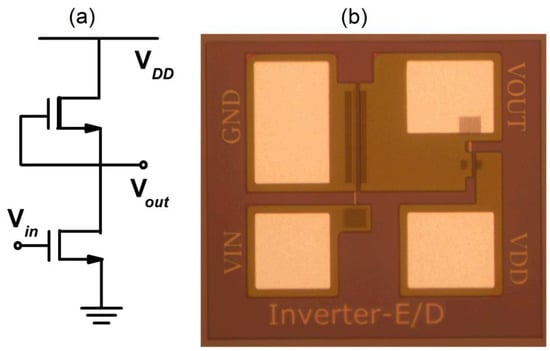
Figure 1.
(a) A typical circuit schematic of the E/D-mode GaN inverter and (b) top view of the fabricated E/D-mode inverter.
The key processing steps of the E/D-mode GaN monolithic integration technology are shown in Figure 2. The E/D-mode GaN inverters were fabricated on p-GaN/AlGaN/GaN epitaxial layer on a 150-mm Si substrate. The epitaxial layer was grown through metal organic chemical vapor deposition (MOCVD) and included about 200-nm AlN nucleating layer, about 3.5-μm high resistive buffer layer, about 300-nm un-doped GaN channel layer, and about 18-nm Al0.13Ga0.87N barrier layer. Then, about 90-nm p-type GaN layer was grown and the Mg concentration was about 1 × 1019 cm−3. Finally, it was annealed within the MOCVD chamber at 650 °C for 15 min.
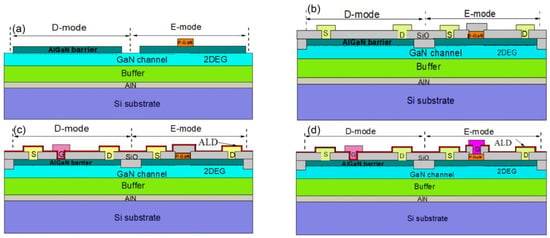
Figure 2.
Schematic cross-section of (a) after p-GaN etching, (b) after source and drain formation and (c) after gate metal etching of the D-mode GaN high-electron-mobility transistor (HEMT) device and (d) after the gate metal etching of the E-mode GaN HEMT device.
The E-mode and D-mode GaN HEMT were fabricated in the same batch. For E/D-mode GaN devices and inverters’ fabrication, the mesa region was formed with N ion implantation. Then p-GaN etching was carried out by BCl3/Cl2-based inductive couple plasma (ICP) with low DC power for low damage and high etching selectivity with Al0.13Ga0.87N. In this step, the p-GaN was totally etched for D-mode GaN HEMT and was partly left as p-GaN gate for the E-mode GaN HEMT. Then, plasma-free SiO2 chemical vapor deposition (CVD) was deposited as the first passivation. Au-free ohmic contact metal stack Ti/Al/Ti/TiN was sputtered after SiO2 etching. The ohmic contact metal was patterned by BCl3/Cl2 dry etching process. After that, the sample was annealed at 850 °C for 30 s in N2 ambient and the ohmic contact resistance was 0.6 Ω·mm. After removing SiO2 by SF6 plasma etching, about 20-nm atom layer deposition (ALD) Al2O3 was deposited at 200 °C as the gate dielectric for the D-mode device. Then, TiN was deposited and defined by ICP etching as the gate metal for D-mode GaN HEMT. For the E-mode GaN device, the gate window was opened by etching Al2O3 and SiO2 with low DC bias and Ti/Al gate metal was deposited and defined by ICP etching. Lastly, about 100-nm plasma enhancement chemical vapor deposition (PECVD) was deposited as the last passivation, and then the pad contact was opened by wet etching. D-mode and E-mode have a gate length of 1.5-μm and 1.8-μm, respectively. Both the D-mode and E-mode have the same gate width of 100-μm, gate-to-source distance of 1.5-μm, and gate-to-drain distance of 5-μm. I-V measurement was performed using Aglient B1500 semiconductor device analyzer.
3. Results
3.1. E/D-Mode GaN HEMTs
The DC output and transfer characteristics of E/D-mode HEMTs fabricated on the same wafer are plotted in Figure 3 and Figure 4. At room temperature (RT), the threshold voltage VTH is +1.2 V and −14.5 V for E-mode and D-mode GaN HEMT by linear extraction method, respectively. The maximum drain current density IDS,max is 312 mA/mm (at VGS = 7 V) for the E-mode HEMT and 378 mA/mm (at VGS = 2 V) for the D-mode HEMT. The maximum current density for D-mode HEMT is lower than normal devices should be, as a result of the lower Al concentration of the AlGaN barrier layer. As the limitation of the probe, the highest test temperature is 200 °C in the paper. At 200 °C, the VTh of the E-mode HEMT is 1.1 V and with 0.1 V drift. The E-mode HEMT exhibits a maximum current density of 152 mA/mm at 200 °C, which is about 52% lower than that at room temperature. The lower maximum current density at high temperature may be due to the low mobility of the 2DEG, caused by impurity scattering [13,14]. For the D-mode HEMT the VTH increases to −12.4 V, with +2.1 V drifting at 200 °C. The larger VTH shifting for the D-mode HEMT at high temperature may be due to the fact that the 2DEG is captured by the interfaces of the gate metal/Al2O3/AlGaN structure [15]. The maximum current density of the D-mode exhibits 64% lower and it is 179 mA/mm.

Figure 3.
Direct current (DC) output and transfer characteristics for (a) E-mode GaN HEMT with LG/LGS/LGD = 1.8/1/5-μm and (b) D-mode GaN HEMT with LG/LGS/LGD = 1.5/1/5-μm.

Figure 4.
Gate leakage current for both E-mode and D-mode at room temperature and 200 °C.
Figure 4 plots the gate leakage characteristics of the E-mode and D-mode HEMTs. Both of them can operate safely at −6 V ~ +6 V at room temperature and 200 °C. The off-state gate leakage current increases about two orders of magnitude with the increase of temperature for the E-mode HEMT. The D-mode HEMT shows much lower gate current leakage at the forward bias and this may due to the high insulation quality of ALD Al2O3 layer.
3.2. E/D GaN Inverters
As shown in Figure 1a, the D-mode HEMT serves an active load and the E-mode HEMT serves as a driver of the inverter. In this paper, the gate-source-shorted D-mode HEMT is with a WG/LG = (14-μm/1.5-μm), and different driver-to-load resistance ratio α = (W/L)E/(W/L)D is fabricated with different (W/L)E. Figure 5 shows a typical E/D-mode GaN inverter with a driver/load ratio α = 15 and a supply voltage VDD = 3 V. The red curve is the same transfer curve with the axis interchanged and represents the input-output characteristics. The output high (VOH) and low (VOL) voltage of the inverter are 3.0 V and 0.09 V, respectively, yielding a large voltage swing of 2.91 V (97%), close to the best values in the literature [10] with α = 64. The input logic low (VIL) and high (VIH) voltage level, extracted from the voltage unit gain points (G = dVOut/dVin = −1), are 0.87 V and 1.33 V, respectively. The transition voltage region VTR (defined as VTR = VIH−VIL) is 0.46 V (15%), close to value as that in literature [10] with α = 64, showing the high performance of the logic inverter. The threshold of the inverter is 1.10 V (VTH,inverter, defined by Vout = Vin). The logic low noise margin (NML = VIL − VOL) is 0.78 V and the high noise margin (NMH = VOH − VIH) is 1.67 V.
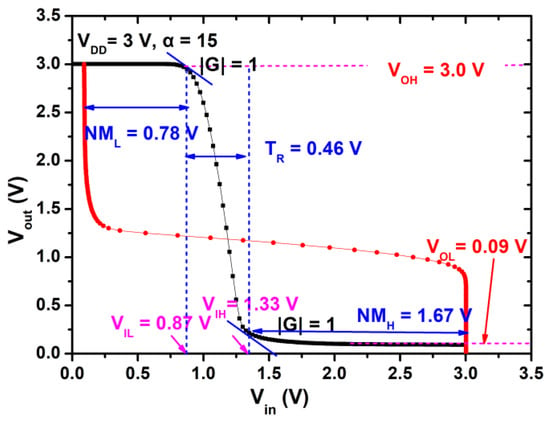
Figure 5.
Static voltage transfer characteristics of the inverter with α = 15 measured at supply voltage VDD = 3 V.
Figure 6 shows the measured voltage transfer characteristics for E/D-mode GaN inverters of different α with VDD = 3 V. Table 1 summarizes the parameters of the inverters.
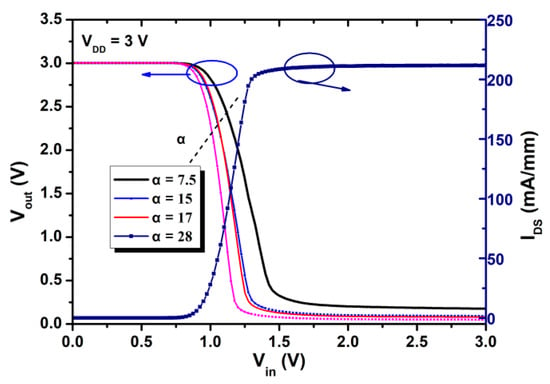
Figure 6.
The static voltage transfer curve of the inverter with different α at VDD = 3V.

Table 1.
Noise margins for inverters with different α.
As shown in Figure 6, the VOH is 3.0 V with all α, indicating that the E-mode HEMTs are well switched off. The VOL is decreasing with larger α and it is only 0.05 V with α = 28. The VOL can be described as below.
When the values of α increase, the RE becomes smaller and equivalent resistance of E-mode transistor is much smaller than the overall resistance of the circuit, and the VOL decreases. Also, larger values of α result in sharper transitions and smaller transition voltage. As a result, the output swing increases from 2.83 V to 2.95 V. As α increases from 7.5 to 28, the threshold of the inverter decreases from 1.30 V to 1.11 V, and the DC voltage gain (G) in the linear region increases from 5.5 to 8.3. Table 1 lists the measured values of static noise margins, as well as VOH, VOL, output logic swing, VTH, inverter, and G. Both NML and NMH are improved as α increases. However, on the other hand, as the active load D-mode HEMT is kept unchanged and the gate length of the E-mode is kept as a constant, larger α will increase the capacitance of the E-mode HEMT, and this will decrease the speed of the inverter.
The static voltage transfer curves of the inverter with α = 15 were measured at different supply voltages and are plotted in Figure 7. The circuit performance parameters are listed in Table 2. When supply voltage increases, all the parameters of the E/D inverter increase accordingly. This means that the increase of supply voltage improves the static performance of the E/D inverter. Furthermore, magnitude of increase for the high noise margin is larger than that of the low noise.
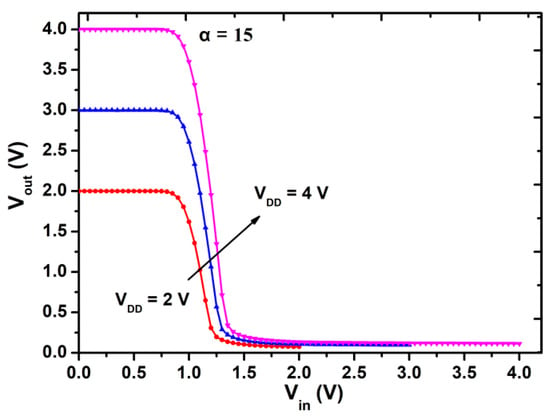
Figure 7.
The static voltage transfer characteristics of the inverter with α = 15 measured at supply voltage VDD = 2, 3, 4 V.

Table 2.
Noise margins for inverters with different VDD with α = 15.
High-temperature performance of the inverter circuits is characterized by varying the temperature from 25 °C to 200 °C in Figure 8. The insert figure plots the DC output and transfer characteristics of the inverter at 200 °C. Table 3 summarizes the parameters of the inverters at different temperature with VDD = 3 V and α = 15.
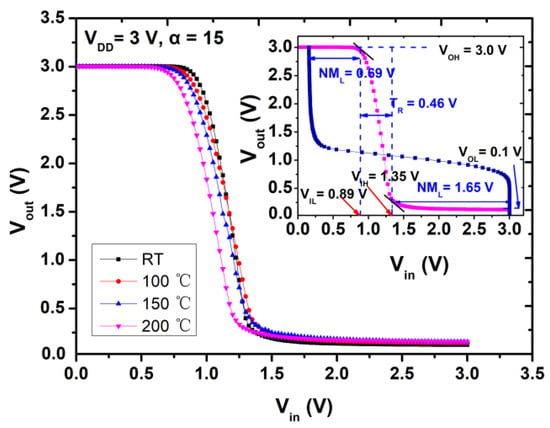
Figure 8.
The static voltage transfer curve of the inverter at different temperature from 25 °C to 200 °C with VDD = 3 V; insert: DC output and transfer characteristics of the inverter at 200 °C.

Table 3.
Noise margins for inverters at different temperature.
As shown in the insert figure in Figure 8, the inverter functions well at VDD of 3 V in terms of VOH, VOL, logic voltage swing, VTH, NML and NMH, and they are 3 V, 0.11 V, 2.89 V, 1.09 V, 0.68 V and 1.72 V, respectively. It should be noted that the VOH of 3 V and VOL of 0.11 V suggest that the inverter can successfully turn-on and turn-off the E-mode device even at 200 °C.Small variations of the inverter from RT to 200 °C can be ascribed to two factors. Firstly, the E-mode HEMT exhibits with a small variation of about 0.1 V at RT and 200 °C. Similar behavior of the threshold voltage was also demonstrated in [10]. Secondly, the low off-state leakage of the E-mode HEMT up to 200 °C is critical for the inverter to obtain a high level VOH and low level VOL at high temperature, making it possible to obtain a large logic voltage swing and noise margins without obvious variations for the inverter in such temperature range. The two factors work together to make this E/D-mode inverter capable of functioning properly up to 200 °C and exhibit small variations in terms of logic voltage swing, VTH, NML and NMH from RT to 200 °C.
Figure 9 shows the transient output waveforms of the fabricated E/D-mode GaN inverters of different α with input of 20 kHz square wave from 0 to 3 V, and an edge time of 10 ns. As α increases from 7.5 to 28, the rising edge time of the output signal increases from 1.05 μs to 1.66 μs. The data are much smaller than that in the literature [15] and this may result from the excellent characteristics of the p-GaN gate E-mode HEMT. Generally, an inverter with smaller α may have poorer DC performance, but it will have better performance for dynamic characteristics. Designers will trade-off between the static and dynamic performance and select a proper α.
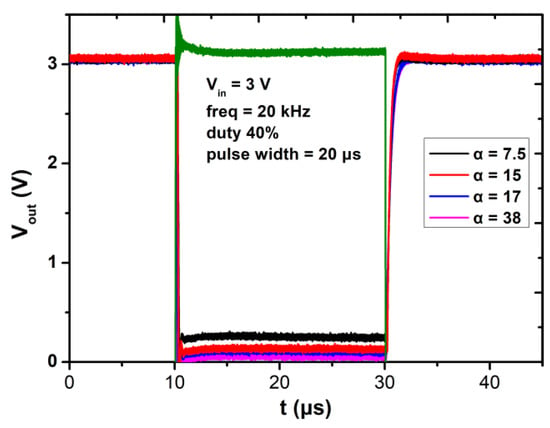
Figure 9.
The transient output waveforms with input of 20 kHz square wave from 0 to 3 V with different α.
4. Conclusions
In this paper, AlGaN/GaN E/D-mode HEMTs and inverters were successfully fabricated on a 150-mm Si wafer based on p-GaN gate technology. The fabricated E/D-mode devices and inverters were characterized and analyzed. The inverter shows large input logic swing voltage, high noise margin and small transition voltage region. Excellent characteristics were displayed at high temperature, and small variations at high temperature in terms of logic voltage. The inverters also demonstrate small rising edge time of the output signal, and the results show great potential for GaN smart power ICs.
Author Contributions
Data curation, J.-P.X.; Formal analysis, D.-F.L. and J.-C.Z.; Investigation, L.Z. and Z.C.; Project administration, Y.-J.A. and Y.Z.; Writing—original draft, L.-F.J.; Writing—review and editing, Y.Z. All authors have read and agreed to the published version of the manuscript.
Funding
This research was funded by by National Key Research and Development Program of China under Grant No. 2017YFB0402903, and the Science Challenge Project under Grant TZ2018003, and the National Natural Science Foundation of China under Grant 61874114, 61674143 and 61974137.
Data Availability Statement
The data presented in this paper is available with request from the corresponding author.
Acknowledgments
We would like to thank Yongjian Lu, Zhenyu Yuan and Nian Liang for support of the fabrication process and thank Qiyang Ma, Zhixiu Cheng and Chenyi Lin for the transient measurement.
Conflicts of Interest
The authors declare no conflict of interest.
References
- Chen, K.J.; Häberlen, O.; Lidow, A.; Tsai, C.L.; Ueda, T.; Uemoto, Y.; Wu, Y. GaN-on-Si Power Technology Devices and Applications. IEEE Trans. Electron Devices 2017, 64, 779–795. [Google Scholar] [CrossRef]
- Lidow, A. Gallium Nitride Integration: Going Where Silicon Power Can’t Go. IEEE Power Electron. Mag. 2018, 5, 70–72. [Google Scholar] [CrossRef]
- Wong, K.; Kwan, M.H.; Yao, F.W.; Tsai, M.W.; Lin, Y.; Chang, Y.; Chen, P.; Su, R.; Yu, J.; Yang, F.; et al. A next generation CMOS-compatible GaN-on-Si transistors for high efficiency energy systems. In Proceedings of the 2015 IEEE International Electron Devices Meeting (IEDM), Washington, DC, USA, 7–9 December 2015; pp. 229–232. [Google Scholar]
- Frolov, F.; Lettl, J. Design of High Efficiency and High Frequency GaN DC/DC Converter. In Proceedings of the 2020 21st International Scientific Conference on Electric Power Engineering (EPE), Prague, Czech Republic, 19–21 October 2020; pp. 1–4. [Google Scholar]
- Wang, B.; Riva, M.; Bakos, J.D.; Monti, A. Integrated circuit implementation for a GaN HFET driver circuit. IEEE Trans. Ind. Appl. 2010, 46, 2056–2067. [Google Scholar] [CrossRef]
- Zhu, M.; Matioli, E. Monolithic integration of GaN-based NMOS digital logic gate circuits with E-mode power GaN MOSHEMTs. In Proceedings of the 2018 IEEE 30th International Symposium on Power Semiconductor Devices and ICs (ISPSD), Chicago, IL, USA, 13–17 May 2018; pp. 236–239. [Google Scholar]
- Micovic, M.; Tsen, T.; Hu, M.; Hashimoto, P.; Willadsen, P.J.; Milosavljevic, I.; Schmitz, A.; Antcliffe, M.; Zhender, D.; Moon, J.S.; et al. GaN enhancement/depletion-mode FET logic for mixed signal applications. IEEE Electron Device Lett. 2014, 35, 336–338. [Google Scholar] [CrossRef]
- Xu, Z.; Wang, J.; Cai, Y.; Liu, J.; Yang, Z.; Li, X.; Wang, M.; Yu, M.; Xie, B.; Wu, W.G.; et al. High Temperature Characteristics of GaN-Based Inverter Integrated with Enhancement-Mode (E-Mode) MOSFET and Depletion-Mode (D-Mode) HEMT. IEEE Electron Device Lett. 2014, 35, 33–35. [Google Scholar] [CrossRef]
- Tang, Y.; Saunier, P.; Wang, R.; Ketterson, A.; Gao, X.; Guo, S.; Snider, G.; Jena, D.; Xing, H.; Fay, P. High-performance monolithically-integrated E/D mode InAlN/AlN/GaN HEMTs for mixed-signal applications. In Proceedings of the 2010 International Electron Devices Meeting, San Francisco, CA, USA, 6–8 December 2010; pp. 684–687. [Google Scholar]
- Cai, Y.; Cheng, Z.; Tang, W.C.; Lau, K.M.; Chen, K.J. Monolithically Integrated Enhancement/Depletion-Mode AlGaN/GaN HEMT Inverters and Ring Oscillators Using CF4 Plasma Treatment. IEEE Trans. Electron Devices 2006, 53, 2223–2230. [Google Scholar] [CrossRef]
- Posthuma, N.E.; You, S.; Stoffels, S.; Wellekens, D.; Liang, H.; Zhao, M.; De Jaeger, B.; Geens, K.; Ronchi, N.; Decoutere, S.; et al. An industry-ready 200 mm p-GaN E-mode GaN-on-Si power technology. In Proceedings of the 2018 IEEE 30th International Symposium on Power Semiconductor Devices and ICs (ISPSD), Chicago, IL, USA, 13–17 May 2018; pp. 284–287. [Google Scholar]
- Zhou, D.C.; Chiu, H.C.; Zhang, J.; Wong, R.K.; Zhao, T.; Zhang, F.; Zhang, M.; Zou, Y.; Chen, L. A Massive Adoption Ready 200mm 40V-650V E-mode GaN-on-Si Power HEMTs Technology. In Proceedings of the 2020 IEEE Applied Power Electronics Conference and Exposition (APEC), New Orleans, LA, USA, 15–19 March 2020; pp. 636–639. [Google Scholar]
- Tang, G.; Kwan, A.M.; Wong, R.K.; Lei, J.; Su, R.Y.; Yao, F.W.; Lin, Y.M.; Yu, J.L.; Tsai, T.; Tuan, H.C.; et al. Digital integrated circuits on an e-mode gan power hemt platform. IEEE Electron Device Lett. 2017, 38, 1282–1285. [Google Scholar] [CrossRef]
- Moench, S.; Reiner, R.; Waltereit, P.; Müller, S.; Quay, R.; Ambacher, O.; Kallfass, I. A 600V p-GaN Gate HEMT with Intrinsic Freewheeling Schottky-Diode in a GaN Power IC with Bootstrapped Driver and Sensors. In Proceedings of the 2020 32nd International Symposium on Power Semiconductor Devices and ICs (ISPSD), Vienna, Austria, 13–18 September 2020; pp. 254–257. [Google Scholar]
- Sun, R.; Liang, Y.C.; Yeo, Y.C.; Zhao, C.; Chen, W.; Zhang, B. All-gan power integration: Devices to functional subcircuits and converter ics. IEEE J. Emerg. Sel. Top. Power Electron. 2020, 8, 31–41. [Google Scholar] [CrossRef]
Publisher’s Note: MDPI stays neutral with regard to jurisdictional claims in published maps and institutional affiliations. |
© 2021 by the authors. Licensee MDPI, Basel, Switzerland. This article is an open access article distributed under the terms and conditions of the Creative Commons Attribution (CC BY) license (https://creativecommons.org/licenses/by/4.0/).